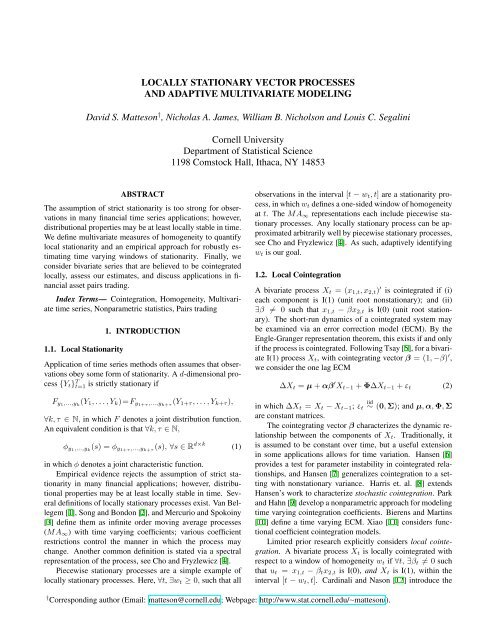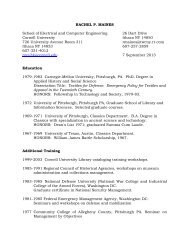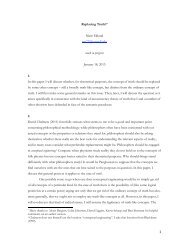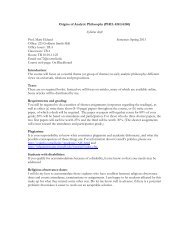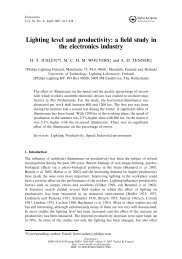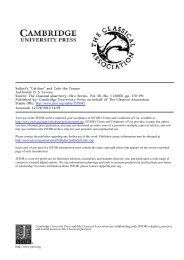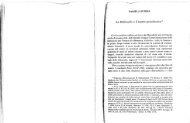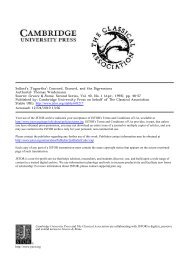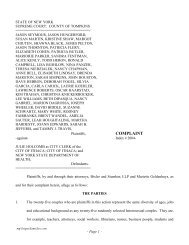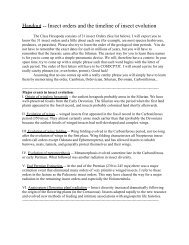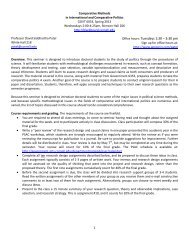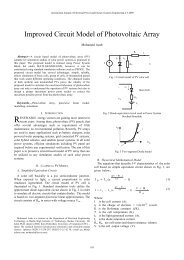LOCALLY STATIONARY VECTOR PROCESSES AND ADAPTIVE ...
LOCALLY STATIONARY VECTOR PROCESSES AND ADAPTIVE ...
LOCALLY STATIONARY VECTOR PROCESSES AND ADAPTIVE ...
You also want an ePaper? Increase the reach of your titles
YUMPU automatically turns print PDFs into web optimized ePapers that Google loves.
<strong>LOCALLY</strong> <strong>STATIONARY</strong> <strong>VECTOR</strong> <strong>PROCESSES</strong><br />
<strong>AND</strong> <strong>ADAPTIVE</strong> MULTIVARIATE MODELING<br />
David S. Matteson † , Nicholas A. James, William B. Nicholson and Louis C. Segalini<br />
Cornell University<br />
Department of Statistical Science<br />
1198 Comstock Hall, Ithaca, NY 14853<br />
ABSTRACT<br />
The assumption of strict stationarity is too strong for observations<br />
in many financial time series applications; however,<br />
distributional properties may be at least locally stable in time.<br />
We define multivariate measures of homogeneity to quantify<br />
local stationarity and an empirical approach for robustly estimating<br />
time varying windows of stationarity. Finally, we<br />
consider bivariate series that are believed to be cointegrated<br />
locally, assess our estimates, and discuss applications in financial<br />
asset pairs trading.<br />
Index Terms— Cointegration, Homogeneity, Multivariate<br />
time series, Nonparametric statistics, Pairs trading<br />
1.1. Local Stationarity<br />
1. INTRODUCTION<br />
Application of time series methods often assumes that observations<br />
obey some form of stationarity. A d-dimensional process<br />
{Y t } T t=1 is strictly stationary if<br />
F y1,...,y k<br />
(Y 1 , . . . , Y k )=F y1+τ ,...,y k+τ<br />
(Y 1+τ , . . . , Y k+τ ),<br />
∀k, τ ∈ N, in which F denotes a joint distribution function.<br />
An equivalent condition is that ∀k, τ ∈ N,<br />
φ y1,...,y k<br />
(s) = φ y1+τ ,...,y k+τ<br />
(s), ∀s ∈ R d×k (1)<br />
in which φ denotes a joint characteristic function.<br />
Empirical evidence rejects the assumption of strict stationarity<br />
in many financial applications; however, distributional<br />
properties may be at least locally stable in time. Several<br />
definitions of locally stationary processes exist. Van Bellegem<br />
[1], Song and Bondon [2], and Mercurio and Spokoiny<br />
[3] define them as infinite order moving average processes<br />
(MA ∞ ) with time varying coefficients; various coefficient<br />
restrictions control the manner in which the process may<br />
change. Another common definition is stated via a spectral<br />
representation of the process, see Cho and Fryzlewicz [4].<br />
Piecewise stationary processes are a simple example of<br />
locally stationary processes. Here, ∀t, ∃w t ≥ 0, such that all<br />
observations in the interval [t − w t , t] are a stationarity process,<br />
in which w t defines a one-sided window of homogeneity<br />
at t. The MA ∞ representations each include piecewise stationary<br />
processes. Any locally stationary process can be approximated<br />
arbitrarily well by piecewise stationary processes,<br />
see Cho and Fryzlewicz [4]. As such, adaptively identifying<br />
w t is our goal.<br />
1.2. Local Cointegration<br />
A bivariate process X t = (x 1,t , x 2,t ) ′ is cointegrated if (i)<br />
each component is I(1) (unit root nonstationary); and (ii)<br />
∃β ≠ 0 such that x 1,t − βx 2,t is I(0) (unit root stationary).<br />
The short-run dynamics of a cointegrated system may<br />
be examined via an error correction model (ECM). By the<br />
Engle-Granger representation theorem, this exists if and only<br />
if the process is cointegrated. Following Tsay [5], for a bivariate<br />
I(1) process X t , with cointegrating vector β = (1, −β) ′ ,<br />
we consider the one lag ECM<br />
∆X t = µ + αβ ′ X t−1 + Φ∆X t−1 + ε t (2)<br />
iid<br />
in which ∆X t = X t − X t−1 ; ε t ∼ (0, Σ); and µ, α, Φ, Σ<br />
are constant matrices.<br />
The cointegrating vector β characterizes the dynamic relationship<br />
between the components of X t . Traditionally, it<br />
is assumed to be constant over time, but a useful extension<br />
in some applications allows for time variation. Hansen [6]<br />
provides a test for parameter instability in cointegrated relationships,<br />
and Hansen [7] generalizes cointegration to a setting<br />
with nonstationary variance. Harris et. al. [8] extends<br />
Hansen’s work to characterize stochastic cointegration. Park<br />
and Hahn [9] develop a nonparametric approach for modeling<br />
time varying cointegration coefficients. Bierens and Martins<br />
[10] define a time varying ECM. Xiao [11] considers functional<br />
coefficient cointegration models.<br />
Limited prior research explicitly considers local cointegration.<br />
A bivariate process X t is locally cointegrated with<br />
respect to a window of homogeneity w t if ∀t, ∃β t ≠ 0 such<br />
that u t = x 1,t − β t x 2,t is I(0), and X t is I(1), within the<br />
interval [t − w t , t]. Cardinali and Nason [12] introduce the<br />
† Corresponding author (Email: matteson@cornell.edu; Webpage: http://www.stat.cornell.edu/∼matteson/).
more general notion of costationarity. The components of X t<br />
are costationary if there exist “deterministic, complexity constrained<br />
sequences” {a t } and {b t } such that a t x 1,t + b t x 2,t<br />
is a stationary process. Unfortunately, unique solutions may<br />
not exist, and no procedure is currently available to identify<br />
which is best.<br />
2. MEASURING HOMOGENEITY<br />
Let Z 1 , . . . , Z T ∈ R d be a sequence of vector observations<br />
with E|Z t | 2 < ∞, ∀t. Let A and B denote two disjoint subsets<br />
of {Z t }, each with contiguous observations. Matteson<br />
and James [13] show that for independent sequences, a nonnegative<br />
divergence measure based on characteristic functions<br />
can be used to consistently estimate arbitrary changes in distribution.<br />
Here, we similarly propose measuring divergence<br />
in distribution with respect to empirical characteristic functions<br />
ˆφ. A first order divergence measure ̂D(A, B; α) is defined<br />
as<br />
∫R d | ˆφ A (s) − ˆφ B (s)| 2 (<br />
2π<br />
d<br />
2 Γ( 2−α<br />
2 )<br />
α2 α Γ( d+α<br />
2 ) |s|d+α ) −1<br />
ds, (3)<br />
for some α ∈ (0, 2). We use α = 1 in Section 3.<br />
This may easily be extended to higher orders by jointly<br />
considering lagged values of the process. For example, a second<br />
order measure considers two disjoint subsets of the process<br />
{(Z t, ′ Z t−1) ′ ′ } ∈ R 2d , evaluated analogously to Equation<br />
(3). When the observations within each subset are homogeneous,<br />
the first order measure may be used to test Equation (1)<br />
at a particular τ, for k = 1, while the second order measure<br />
simultaneously considers k = 1, 2.<br />
We apply this divergence measure to identify a window<br />
of homogeneity at time t by first dividing the series<br />
into K + 1 subsets, each of size δ ≥ 2, as follows: let<br />
A = {Z t−δ+1 , . . . , Z t } and, given a strictly increasing sequence<br />
{d i } ∈ N, let B i = {Z t−2δ+2−di , . . . , Z t−δ+1−di }.<br />
Here, A is disjoint from each B i , but the B i may not be<br />
disjoint. We then iteratively test for homogeneity between<br />
subsets A and B i for i = 1, 2, ..., K, as detailed in Section<br />
2.1. If the null hypothesis of homogeneity between<br />
A and B i is rejected, the procedure terminates and returns<br />
w t = max(δ, δ − 1 + d i ); otherwise, we increase to index<br />
i + 1 and repeat.<br />
2.1. Testing<br />
In this section we outline a testing procedure tailored for a<br />
bivariate series {X t } that is believed to be cointegrated locally.<br />
We first assume that at time t the local cointegration<br />
conditions hold for the interval [t − δ + 1, t], such that both<br />
Z t = ∆X t and u t = x 1t − βx 2t are stationary. Here, β is<br />
estimated using ordinary least squares (OLS) over this interval,<br />
as discussed in Section 3. We now construct the subset A<br />
of {Z t }, as in the previous section, and analogously construct<br />
a subset C of {u t }. Similarly, we construct the subsets B i<br />
of {Z t }, as well as corresponding subsets D i of {u t }. Note<br />
that the subsets D i are based on the original estimate of β.<br />
Finally, we define a joint test statistic as<br />
̂D i = ̂D(A, B i ; α) + ̂D(C, D i ; α). (4)<br />
̂D<br />
(r)<br />
i<br />
The distribution of ̂D i under the dual homogeneity null<br />
hypothesis is unknown; we propose to approximate it via simulation.<br />
We consider the serial dependence of Z t and u t via<br />
a VAR(1) and AR(1) model, respectively. We estimate the<br />
mean and variance parameters for each sequence via OLS, using<br />
the subsets A and C, respectively. Based on these parameter<br />
estimates, we generate new sequences {Zt ∗ } and {u ∗ t },<br />
with normally distributed errors. The series are initialized at<br />
Zt−2δ+2−d ∗ i<br />
= Z t−2δ+2−di and u ∗ t−2δ+2−d i<br />
= u t−2δ+2−di .<br />
This is repeated R times, and for the rth simulation, we calculate<br />
= ̂D(A ∗ , Bi ∗; α) + ̂D(C ∗ , Di ∗ ; α), analogous to<br />
Equation (4). Finally, we calculate an approximate p-value<br />
for ̂D i as #{r : ̂D i ≤ }/R.<br />
̂D<br />
(r)<br />
i<br />
3. APPLICATION<br />
We apply the proposed adaptive window estimation method<br />
to potentially cointegrated stocks prices. We consider the<br />
adjusted daily closing stock prices for Coca-Cola (KO) and<br />
Pepsi (PEP), Hewlett-Packard (HPQ) and Dell (DELL), Wal-<br />
Mart (WMT) and Target (TGT), and Chevron (CVX) and<br />
Exxon Mobil (XOM). For each of these pairs we perform<br />
analysis for the time period January 2007 through November<br />
2012. The adjusted daily closing prices are shown in<br />
Figures 1(a) and 2(a)(b)(c), respectively. We use δ = 30,<br />
d i = i, R = 100 and 0.10 as the significance level for our<br />
testing. When applied iteratively, the significance level only<br />
corresponds to the individual marginal tests.<br />
We used OLS to perform our procedure instead of the<br />
maximum likelihood method of Johansen [14] due to the latter’s<br />
irregular finite sample properties. Phillips [15] remarks<br />
that in small samples, the maximum likelihood estimator of<br />
the cointegrating vector has no finite moments, which can<br />
lead to extremely large cointegration coefficients.<br />
For each pair, we perform our estimation procedure over<br />
each locally stationary window estimate [t − w t , t], shown in<br />
Figures 1(b) and 2(d)(e)(f). For the KO-PEP pair, the values<br />
of the local cointegrating coefficient ˆβ(t, w t ), an estimate<br />
over a fixed window length ˆβ(t, ¯w = 68), as well as a cumulative<br />
window ˆβ t with [1, t], are shown in Figure 1(c).<br />
We perform a Dickey Fuller test to provide an additional<br />
check that the cointegrating vector produces an I(0) process.<br />
As stated in Zivot [16], the Dickey Fuller test examines the<br />
cointegrated series {û t } and tests the hypotheses H 0 : û t ∼<br />
I(1) versus H 1 : û t ∼ I(0). It should be noted since the test
(a)<br />
(b)<br />
Adjusted Daily Closing Stock Price<br />
20 30 40 50 60 70<br />
PEP<br />
KO<br />
Year<br />
2007 2009 2011 2013<br />
[t−w t ,t]<br />
2007 2009 2011 2013<br />
2007 2009 2011 2013<br />
Year<br />
Year<br />
(c)<br />
(d)<br />
Cointegration Coefficient<br />
−0.5 0.0 0.5<br />
[t−w t,t]<br />
[t−w,t]<br />
[1,t]<br />
Dickey Fuller Test Statistic<br />
−4 −3 −2 −1 0 1<br />
Test Statistic<br />
10% C.V.<br />
5% C.V.<br />
1% C.V.<br />
2007 2009 2011 2013<br />
2007 2009 2011 2013<br />
Year<br />
Year<br />
Fig. 1. (a) The Pepsi (PEP) and Coca-Cola (KO) adjusted daily closing stock prices for January 2007 through November 2012;<br />
(b) [t − w t , t], our estimated window of local stationarity at times t; (c) estimated local cointegrating coefficient ˆβ(t, w t ) over<br />
locally stationary windows [t − w t , t], ˆβ(t, ¯w), estimated over a fixed width window [t − ¯w, t] using width 68, the mean of<br />
w t , and ˆβ t , the cointegrating coefficient using all available data up to time t; (d) Dickey-Fuller test statistic over each locally<br />
stationary window, along with 1, 5, and 10 percent critical values, which are used to confirm whether the cointegrated process<br />
is unit root stationary over each interval [t − w t , t].<br />
is residual based, the distribution of the test statistic is nonstandard<br />
and follows a “Dickey Fuller Table.” Figure 1(d)<br />
shows the Dickey-Fuller test statistic for the KO-PEP series,<br />
along with the 10, 5, and 1 percent critical values. Since large<br />
negative values provide evidence for rejection of H 0 , the test<br />
implies that {û t } has extended periods of local stationarity.<br />
3.1. Pairs trading<br />
Pairs trading is a strategy that was developed in the 1980s at<br />
Morgan Stanley, and elsewhere. It involves selecting a pair of<br />
stocks that have correlated prices, then buying the relatively<br />
cheaper stock, while shorting the relatively expensive stock.<br />
The positions are entered when the prices have diverged and<br />
exited once the prices converge.<br />
Although correlated stock prices indicate a linear association<br />
over time, there is no guarantee divergent prices will necessarily<br />
converge. However, the relative prices, or the spread<br />
u t , for pairs that are cointegrated will have an equilibrium;<br />
mean reversion of u t may be used to improve trading decisions.<br />
Several authors have proposed various execution criteria.<br />
Dunis et al. [17] open a position when the spread has diverged<br />
from its historical mean by two historical standard deviations.<br />
They exit once the spread has returned to within half of one<br />
standard deviation from the mean. Gatev et al. [18] use a<br />
similar approach. Historical backtesting is conducted to justify<br />
the two standard deviation rule. To rely less on historical<br />
data, Ehrman [19] proposes normalizing the pair’s divergence<br />
by taking the absolute pair difference, subtracting<br />
the 10-day moving average and then dividing by the 10-day<br />
standard deviation. Alternatively, the relative strength index,<br />
which indicates oversold and overbought conditions, is applied<br />
in Ehrman [19].<br />
Any of the above strategies may be implemented using<br />
the proposed adaptive window of homogeneity index w t . For<br />
example, at time t we may implement a standard deviation<br />
rule using û t = ̂mean(u s : s ∈ [t − w t , t]) and ˆσ 2 t = ̂var(u s :<br />
s ∈ [t − w t , t]). Define a normalized process<br />
ũ s = u s − û t<br />
ˆσ t<br />
for s ∈ [t − w t + 1, t + δ].
(a)<br />
(b)<br />
(c)<br />
Adjusted Daily Closing Stock Price<br />
30 40 50 60 70<br />
WMT<br />
TGT<br />
Adjusted Daily Closing Stock Price<br />
10 20 30 40 50<br />
HPQ<br />
DELL<br />
Adjusted Daily Closing Stock Price<br />
50 60 70 80 90 100 110<br />
XOM<br />
CVX<br />
2007 2009 2011 2013<br />
2007 2009 2011 2013<br />
2007 2009 2011 2013<br />
Year<br />
Year<br />
Year<br />
(d)<br />
(e)<br />
(f)<br />
Year<br />
2007 2009 2011 2013<br />
[t−wt,t]<br />
Year<br />
2007 2009 2011 2013<br />
[t−wt,t]<br />
Year<br />
2007 2009 2011 2013<br />
[t−wt,t]<br />
2007 2009 2011 2013<br />
2007 2009 2011 2013<br />
2007 2009 2011 2013<br />
Year<br />
Year<br />
Year<br />
Fig. 2. (a),(b),(c) The adjusted daily closing prices from January 2007 through November 2012 of Walmart (WMT) & Target<br />
(TGT), Hewlett Packard (HPQ) & Dell (DELL), and Exxon Mobil (XOM) & Chevron (CVX), respectively; (d),(e),(f) the<br />
estimated window of local stationarity [t − w t , t], at times t, for WMT & TGT, HPQ & DELL, and XOM & CVX, respectively.<br />
Then, we may enter a position if |ũ t | > 2, and exit at s ><br />
t once |ũ s | < 0.5, |ũ s | > 3, or s = t + δ, whichever is<br />
sooner. This strategy may similarly be implemented using a<br />
fixed width window [t − ¯w, t] or a cumulative window [1, t],<br />
for comparison.<br />
First, for the KO-PEP series we compare the results of<br />
this trading strategy for the three window methods. The first<br />
70 observations are used for initialization, and we use δ =<br />
30. For a fixed width window, ¯w = 68, we entered a trading<br />
position on 14.7% of the 1450 days; the mean return per trade<br />
was -7% and the mean return per day was -3%. Using the<br />
cumulative window [1, t], we entered a position on 26.8% of<br />
the days; the mean return per trade was 12% and the mean<br />
return per day was -2%. Finally, when using the adaptively<br />
estimated window [t − w t , t] via the proposed approach we<br />
entered a trading position on 15.7% of the days; the mean<br />
return per trade was 21% and the mean return per day was 2%.<br />
Positions were held a mean of 7.8 days using the adaptive and<br />
fixed window approaches, and 16.9 days using the cumulative<br />
window.<br />
When applied to the other pairs, similar results were obtained.<br />
For these cases, the proposed adaptive window approach<br />
resulted in a higher mean return per trade than when<br />
using either a fixed or cumulative window, see Table 1. The<br />
mean trade durations in days are shown in Table 2. In most<br />
cases, these higher mean returns were obtained while holding<br />
positions for shorter periods.<br />
Mean Return (per trade)<br />
Window/Pair KO-PEP HPQ-DELL WMT-TGT XOM-CVX<br />
Fixed -7.0% 2.5% -6.6% 0.9%<br />
Cumulative 12.0% -0.9% -0.1% -1.8%<br />
Adaptive 21.0% 4.4% 1.1% 43.0%<br />
Table 1. The mean return (per trade) for the three window<br />
methods on the selected pairs.<br />
Mean Trade Duration (days)<br />
Window/Pair KO-PEP HPQ-DELL WMT-TGT XOM-CVX<br />
Fixed 7.8 9.7 9.7 8.5<br />
Cumulative 16.9 23.0 13.4 17.8<br />
Adaptive 7.8 8.2 8.3 10.6<br />
Table 2. The mean trade duration (days) for the three window<br />
methods on the selected pairs.<br />
4. CONCLUSION<br />
We have proposed a novel method for estimating a window<br />
of homogeneity and extended this approach for adaptively<br />
estimating a window of local cointegration. We apply this<br />
approach to a simple pairs trading strategy and find that an<br />
adaptive window outperforms fixed and cumulative windows,<br />
for the data considered. The realized returns are complexly<br />
related and approximate risk adjustment requires additional<br />
consideration; further analysis is necessary to fully assess the<br />
suitability of this approach for pairs trading in general.
5. REFERENCES<br />
[1] Van Bellegem, S., “Locally stationary volatility modelling,”<br />
in Handbook of Volatility Models and Their Applications,<br />
2011.<br />
[2] Song, L. and Bondon, P., “A local stationary longmemory<br />
model for internet traffic,” in 17th European Signal<br />
Processing Conference, 2009.<br />
[3] Mercurio, D. and Spokoiny, V., “Statistical inference for<br />
time-inhomogeneous volatility models,” Annals of Statistics,<br />
vol. 32, no. 2, pp. 577 – 602, 2004.<br />
[4] Cho, H. and Fryzlewicz, P., “Multiscale breakpoint detection<br />
in piecewise stationary AR models,” in 4th World<br />
Conference of the IASC, 2008.<br />
[16] Zivot, E. and Wang, J., Modeling financial time series<br />
with S-PLUS, Springer Verlag, 2006.<br />
[17] Dunis, C.L., Giorgioni, G., Laws, J. and Rudy, J., “Statistical<br />
arbitrage and high-frequency data with an application<br />
to Eurostoxx 50 equities,” Liverpool Business School,<br />
Working paper, 2010.<br />
[18] Gatev, E., Goetzmann, W.N. and Rouwenhorst, K.G.,<br />
“Pairs trading: Performance of a relative-value arbitrage<br />
rule,” Review of Financial Studies, vol. 19, no. 3, pp. 797–<br />
827, 2006.<br />
[19] Ehrman, D.S., The handbook of pairs trading: Strategies<br />
using equities, options, and futures, Wiley, 2006.<br />
[5] Tsay, R.S., Analysis of Financial Time Series, Wiley,<br />
2010.<br />
[6] Hansen, B.E., “Tests for parameter instability in regressions<br />
with I(1) processes,” Journal of Business & Economic<br />
Statistics, vol. 20, no. 1, pp. 45–59, 1992.<br />
[7] Hansen, B.E., “Heteroskedastic cointegration,” Journal<br />
of Econometrics, vol. 54, no. 1, pp. 139–158, 1992.<br />
[8] Harris, D., McCabe, B. and Leybourne, S., “Stochastic<br />
cointegration: estimation and inference,” Journal of<br />
Econometrics, vol. 111, no. 2, pp. 363–384, 2002.<br />
[9] Park, J.Y. and Hahn, S.B., “Cointegrating regressions<br />
with time varying coefficients,” Econometric Theory, vol.<br />
15, no. 5, pp. 664–703, 1999.<br />
[10] Bierens, H.J. and Martins, L.F., “Time varying cointegration,”<br />
Econometric Theory, vol. 26, no. 05, pp. 1453–<br />
1490, 2010.<br />
[11] Xiao, Z., “Functional coefficient cointegration models,”<br />
Journal of Econometrics, vol. 152, no. 2, pp. 81–92, 2009.<br />
[12] Cardinali, A. and Nason, G.P., “Costationarity of locally<br />
stationary time series,” Journal of Time Series Econometrics,<br />
vol. 2, no. 2, 2010.<br />
[13] Matteson, D.S. and James, N.A., “A nonparametric approach<br />
for multiple change point analysis of multivariate<br />
data,” under review, 2012.<br />
[14] Johansen, S., Likelihood-based inference in cointegrated<br />
vector autoregressive models, Cambridge University<br />
Press, 1995.<br />
[15] Phillips, P.C.B., “Some exact distribution theory for<br />
maximum likelihood estimators of cointegrating coefficients<br />
in error correction models,” Econometrica, vol. 62,<br />
no. 1, pp. 73–93, 1994.


